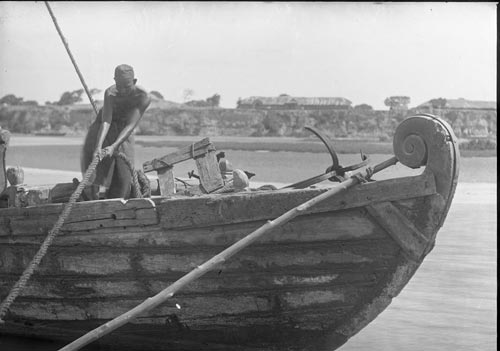Visions of the past: 19th century Ceylon in pictures

A sailing craft with a special prow design from the Red Sea coast, photographed at Arippu in 1907
For the first time, in many decades an exhibition of 19th century photographs will be held in Galle at the Galle Fort Hotel. These digital copies of the original photographs are from the Edward Atkinson Hornel’s Archival Collection which the painter bequeathed to the Scottish National Trust.
The exhibition from January 25-28 will be complemented by two lectures focusing on the history of 19th century photography and its links with Galle.
Made available to the Sri Lanka National Trust (SLNT), the photographs were first displayed in Colombo at the Lionel Wendt Art Centre, Harold Pieris Gallery from January 13-16 last year and then at Jaffna University and the British Council, Kandy. Now being exhibited at Galle Fort Hotel they will move to the Ruhuna University, Matara on January 31. Funding from the British Council, Colombo has enabled SLNT to hold the exhibition in four sites.
Edward Atkinson Hornel (1864-1933) was a Scottish artist who toured Asia from 1907 visiting Sri Lanka, Myanmar and Japan. Hornel and his sister Elizabeth were hosted by their cousin James Hornell (1865-1949) and Hornel took more than 300 photographs of Sinhalese and Tamil men and women in search of subjects for his brush. His cousin James was a gifted marine biologist working for the British Government and was often stationed on the North Western coast, where he had his laboratory while supervising the operation of the pearl fisheries.
One of the highlights of the exhibition is thus a selection of rare images of the activities of the pearl fisheries conducted in the Gulf of Mannar off the coast of Arippu.
While the images on display thematically fall into three categories- Pearl Fisheries, Tea Plantations and Low Country portraits, the most rare are the photographic records of the pearl fisheries. Although scattered examples of these images do exist in specialized journals and reports, for the best part they are detailed accounts on marine biology and the scientific study of the formation of pearls. We hardly encounter images of those individuals from the towns and villages of the Red Sea Coast and western coastal India who were some of the principal participants in the industry. Among the images are the numerous elegant, sailing crafts from the Gulf countries and India which plied the Indian Ocean.
Photography made its landfall in this` country in the early 1840s and was able to supply us with some vivid records of landscapes and people of the latter half of the 19th and early twentieth century. These unique images were taken under stressful conditions. The problems of damp, dust, heat, humidity, insect infestation and rot in a tropical environment were only minor, and just a small part of the story.
To a 19th century photographer using the Wet Plate process the chemical ingredient collodion was one of the most vital components for developing his negatives. But this highly explosive, volatile and unstable chemical formed the active ingredient of smokeless gunpowder and hence was altogether banned from being transported by most of the steamship companies including the P&O, the major liner that served Sri Lanka during this period. The chemical had often to be relayed to India and Sri Lanka overland.
Photographers operating here had also to contend with the highly unstable social and economic conditions that prevailed in the country. The images of tea plantations were taken just a decade after the substitution of the new crop following the coffee blight.
Although these images that portray of young girls plucking tea seem appealing, the depressing aspect of the hardships of the immigrant labour sourced from South India cannot be ignored.
In contrast the few idyllic images of life in rural Sri Lanka are elegantly displayed in scenes depicting activities during the festival periods.
Also, of interest to historians are those of costume, dress, body ornaments and jewellery worn by the Sinhalese rural women during these auspicious religious periods.
(The writer is President of the Sri Lanka National Trust)
Searching for an ideal partner? Find your soul mate on Hitad.lk, Sri Lanka's favourite marriage proposals page. With Hitad.lk matrimonial advertisements you have access to thousands of ads from potential suitors who are looking for someone just like you.


